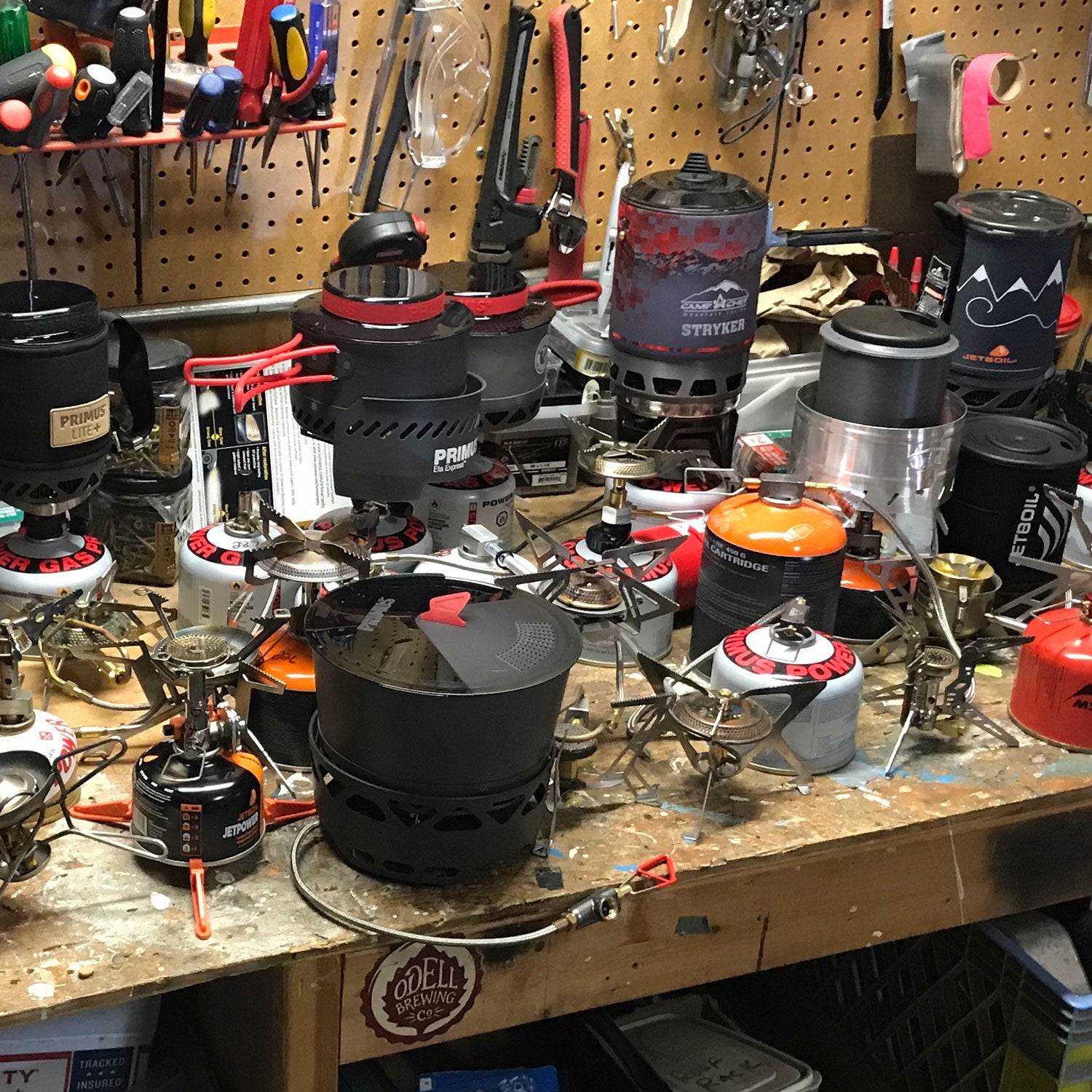What’s the best backpacking stove? To answer this question, I tested 29 stove models from six different brands, interested only in those that I’d be happy to carry for an extended outing in the backcountry and run on either white gas or isobutane canisters—stoves that 90 percent of the backcountry-going public would be interested in.
My favorite from that pool was the stove set. It’s reasonably priced, simmers well, boils quickly, and comes with everything I needed to cook in the backcountry. Other stoves in this test make more sense for people who are on a budget, backpack alone, or plan to go on remote expeditions, and I’ve written about several of those options below. But for a general-purpose camp stove, the Primetech is tough to beat.
Our Favorite Backpacking Stove
Primus Primetech (From $130)
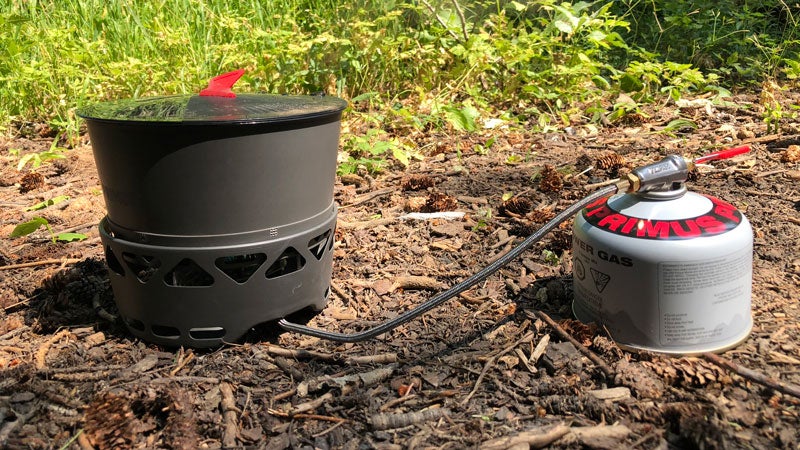
I hesitate to write “one and done,” “far and away the best stove I tested,” “runaway winner,” and so on, but that’s kinda how I feel about the . The Primetech is an isobutane stove using a remote canister system and comes in two sizes: one that weighs 487 grams and comes with a large 2.3-liter integrated pot, and one that weighs 287 grams, comes with a 1.3-liter pot, and is perfect for two campers.
The Primetech runs on single-use isobutane canisters, which you’ve probably seen in your local outdoor store. A burner attaches to the isobutane canister via a six-inch hose, whereas with pedestal-style and integrated stoves, generally the burner attaches directly over the canister. ( is the best-known integrated-style stove; for a more detailed explanation of stove and fuel options, see the section at the end of this article.)
As fortune would have it, the Primetech was the last stove I tested and by far the most impressive. For $130, it comes with a burner, integrated windscreen, lid, handle, a simple pot, and a pot with an integrated heat exchanger. (Heat exchangers are fins attached to the bottom of the pot that help distribute heat more evenly.) That’s everything most backpackers will need and then some.
The Primetech wasn’t an outright winner in many of the categories tested—the , at 56 grams, was much lighter, and the  was much cheaper at $20—but it was often second best, and when the Primetech lost to stoves in one category, it typically flattened them in others. The Primetech was the quietest stove tested, and its simmer function was second only to the GSI Halulite Minimalist, which took more than a minute longer to boil water. Its mechanism for adjusting how far above the burner the pot sits was the nicest to operate and made it easier to avoid burning rice, a perennial challenge with camp stoves. Its boil time for a half-liter of water was also second fastest at 1:50, only 15 seconds behind the category-winning Jetboil MilliJoule, and that stove doesn’t really simmer. Plus, while we didn’t test any of these stoves in true winter conditions, the Primetech should perform well in cold temps: The remote canister system can be inverted for improved efficiency, and it has a regulator, which helps maintain optimal fuel pressure. Both features are helpful in cold weather.
Of course, this stove does have its downsides. While isobutane canisters are becoming increasingly popular worldwide, they’re still hard to come by in some destinations. (Usually, a bit of internet research before traveling will reveal where to find them.) And while isobutane stoves are generally adequate for winter use, they’re not quite as good as liquid fuel or white gas stoves. Finally, the Primetech lacks a piezoelectric, or push-button, ignition. These buttons are convenient but finicky and always need to be backstopped with a reliable lighter or matches. As such, I didn’t give that feature much weight in this review.
In short, this stove does everything exceptionally well, includes everything you need, and comes in a great little package.
Best Stove for the Budget-Conscious Weekend Warrior
Jetboil MightyMo ($50)
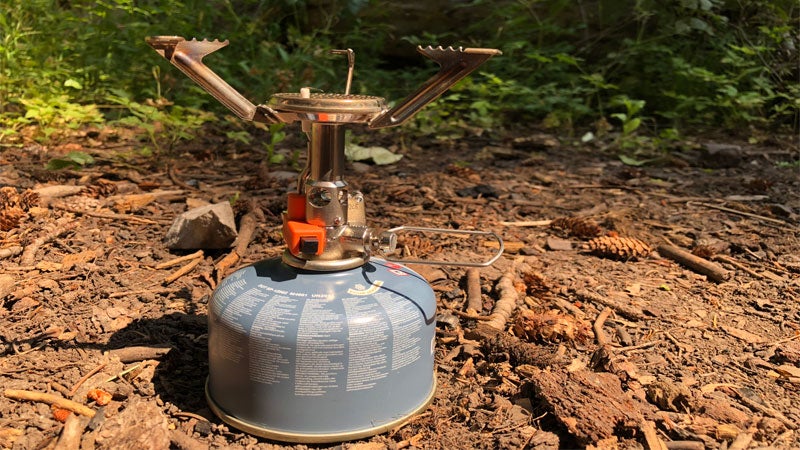
For a simple, inexpensive, and easy-to-set-up stove, it’s tough to beat the . At 197 grams with the fuel canister included and retailing for $50, the MightyMo hits a sweet spot in the budget-friendly pedestal stove category. It will work well as a stove for two people, and it was quick and reliable to operate in my tests.
That said, many of the pedestal stoves I tested would be good bets for anyone looking to optimize for simplicity and keep costs low. Keep an eye out for the , , and the Ěý´Ç°ů from Snow Peak. There aren’t huge differences between any of these stoves. They’re similarly priced, weigh within about 20 grams of each other, and posted boil times that varied by only about 30 seconds for a half-liter of water. The one exception is the , which at $20 was the least expensive stove reviewed, but at 194 grams without a pot or fuel, it was the heaviest of the pedestal stoves. Still, I liked the MightyMo’s combination of price, weight, and quick 2:15 boil time.
Two final reservations: While you can probably make it work, none of the stoves in this category are great for cold-weather camping. Nor are they great for more than about two people—with all pedestal stoves, things start getting unstable when you use a big pot.
Best Stove for International or Lengthy Expeditions
MSR WhisperLite Universal ($140)
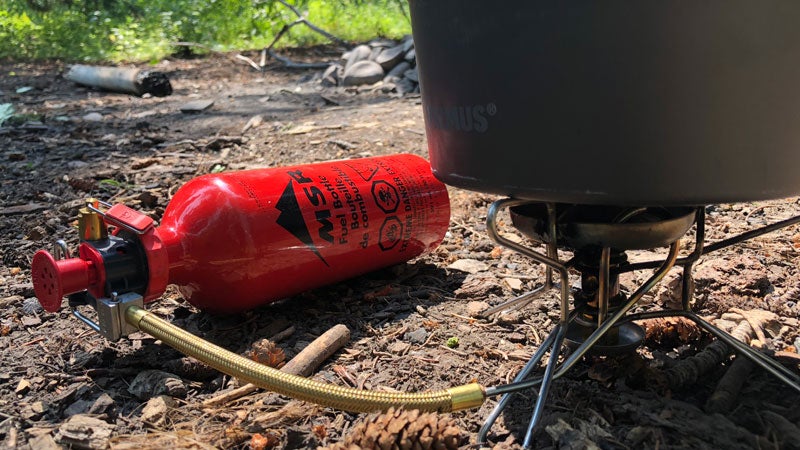
For certain trips, you want a stove that you can count on no matter where you find yourself, one that you can repair after anything shy of an elephant stampede, and one that will burn pretty much whatever you put in it, including tap water from Flint.
The was the first stove I owned and is arguably the most popular backpacking stove in existence. I still have the same WhisperLite I bought in college in 2001, and I’ve used it in Alaska, the desert Southwest, and Peru, and I plan to take it bikepacking in Nepal this fall. If you expect to travel to remote locations, this is the stove to buy.
The WhisperLite makes sense for remote travel for two primary reasons: its ability to run on diverse fuels, and its reparability. Otherwise excellent stoves like the Primetech are limited to burning isobutane canisters, which may be harder to find. Using isobutane, the WhisperLite boiled water slower than the Primetech (3:01 versus 1:50 for a half-liter), but the difference is that it can boil water using almost anything—isobutane, white gas, and kerosene all work well. I’ve never had trouble finding fuel for the WhisperLite, even in villages in the Peruvian Andes. Similarly, if something breaks on the Primetech, you’re likely out of luck. MSR, however,  that’s the size of a pack of gum and comes with enough spare parts to virtually rebuild the WhisperLite.
The biggest downside of going with a multifuel stove like the WhisperLite is that they all come with learning curves, particularly when substituting fuels. There’s a lot more to break or clog on a multifuel system. As a result, these stoves require more maintenance, which naturally requires knowing how to take these stoves apart and clean them, as well as understanding that they operate differently when using different fuels. On isobutane, for example, the WhisperLite burns for a full minute after you turn it off. And when using white gas or other liquid fuels, there’s a priming period to get the stove running, usually about 60 seconds. That means it’s not a perfect choice if efficiency is a major priority.
In the multifuel category, the ($140) was better at adjusting simmering temperatures, and while it was substantially louder than the WhisperLite, it is still an excellent stove. But in the many hundreds of days I’ve spent using the WhisperLite, I’ve never run into a problem I couldn’t fix in 15 minutes, and its flexibility and reliability are enough to keep it in my pack. And while it hasn’t been trampled by elephants, my WhisperLite was actually stomped into the mud by an errant group of backcountry cattle a few years back, which is pretty close. It’s still going strong.
Best Stove for Minimalists
GSI Halulite Minimalist ($75)
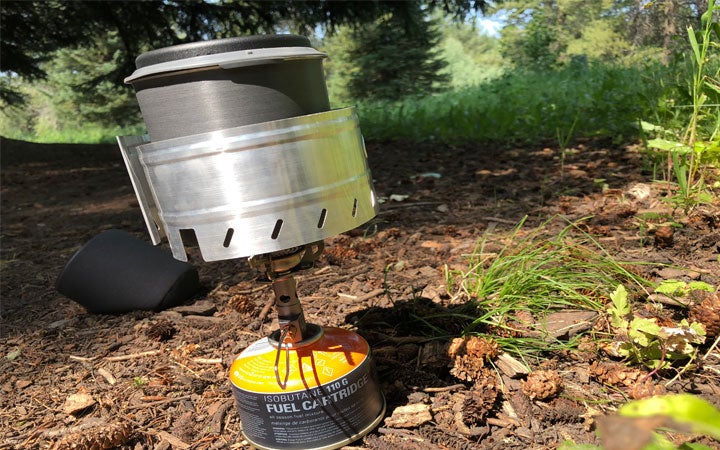
There are people—I’m not one of them—who get upset that they even have to carry a stove in the first place, people for whom cooking is at best an inconvenient necessity and whose packs are probably home-built from single-ply toilet paper. You know the type. If you’re in this category, or if you just want a warm cup of coffee and water for instant oatmeal in the morning, or if you’re among the many backpackers who prioritize size and simplicity, I recommend the aptly named , a 236-gram pedestal stove (pot included) that runs on isobutane and retails for $75.
The Halulite Minimalist is simple and small. Everything is well designed, from the removable pot koozie to the silicone pot grabber, which reminds me of the rubber finger monsters I had as a kid. It comes in the most compact package of the complete stove kits I tested and is impressively light. The 3:35 half-liter boil time wasn’t the fastest of the test, but if all you’re doing is heating water for coffee, an extra 30 seconds isn’t a big deal. And if you decide to do some real cooking, it also simmered surprisingly well.
If the Halulite seems too bare-bones, take a look at Jetboil’s closest competitor, the , an integrated stove that’s about 130 grams heavier and much more expensive at $135, but it has a pot that is better suited to couples and boils water faster.
Best Stove to Keep in Your Car
Camp Chef Stryker 200 ($100)
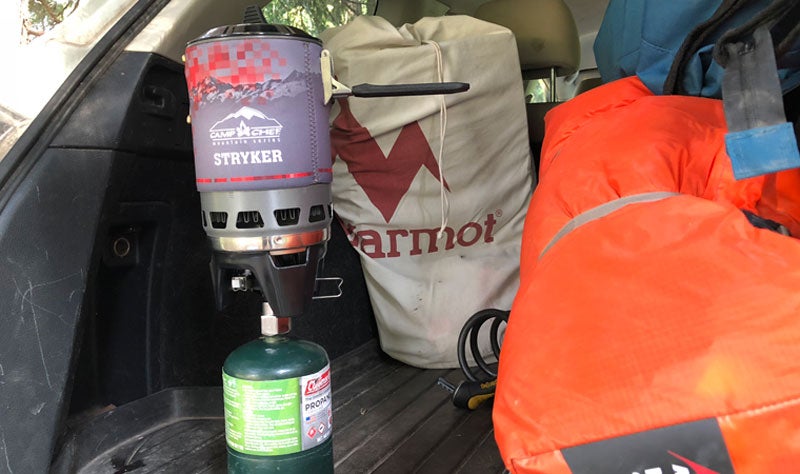
Aside from its clean design, the  is the only isobutane canister stove I’ve seen that can be converted for use with the standard one-pound propane canisters that are ubiquitous at sporting goods stores across the country. As a backpacking stove, it’s relatively light (523 grams with the integrated pot) and small enough to fit in a pack. But its ability to run two kinds of popular fuel would make a lot of sense as a backup car camping stove. If you’re looking for a really simple stove that works reasonably well for both backpacking and car camping, this is it.
What About a Stove for Winter?
I didn’t do enough real-world cold-weather testing to make strong recommendations in this category. But from personal experience and some educated guessing, I’d suggest the MSR WhisperLite Universal or a similar liquid fuel stove, or a remote canister stove such as the Jetboil MilliJoule or the Primus Primetech system.
Liquid fuel stoves get the nod for two reasons. First, I’ve found them to be slightly more reliable than canister stoves when the temps really drop. Second, if you’re going through lots of fuel, as you might on an extended winter expedition, it’s simply more efficient to pack a gallon of white gas than it is to pack dozens of fuel canisters. That said, there are some pretty good cold-weather fuel mixes available for canister stoves, and the ability to invert the canister with a remote system increases efficiency. Both are sensible choices.
How We Tested the Best Backpacking Stove
When selecting stoves to test, I picked brands that are readily available at most outdoor stores in the United States or are carried by reputable online retailers. I decided to skip stoves from small brands that are found only online. I made this decision in order to select for long-term reliability, and many upstart stove companies just haven’t been around long enough to have a track record. In addition, I decided to avoid so-called alternative-fuel stoves, such as those that burn alcohol, pellets, or wood, since those products fit niche markets. Once I had a list of companies, I requested as many models as possible and went to town. In total, I included 29 stoves in the test.
I have a fair amount of personal experience with many of the stoves in the test. I’ve been working in guiding and outdoor education since 2000 and, until recently, spent somewhere between 60 and 150 days a year in the backcountry in environments from winter trips to Alaska to summers in the desert. Based on that experience, I decided to evaluate stoves using the following criteria.
Boil Time: This is a good metric for comparing stoves within a single manufacturer’s lineup, but there’s not really a universal standard for testing, so it may not be a helpful number when comparing Jetboil to Primus, for example. Also, read the advertised boil time carefully. Some stoves list a time to boil a half-liter of water and some a full liter.
Weight: I used a digital kitchen scale to weigh each stove. The lightest stove in the test weighed 56 grams but didn’t come with a pot and accessories. Where possible, I’ve included weights for entire stove systems.
BTUs: This emerged as an almost meaningless metric. For example, the GSI Glacier Camp claims an 11,000 BTU output but needed 3:36 to boil a half-liter of water. The Jetboil MiniMo, however, claims a 6,000 BTU output but boiled the same amount of water in 2:14. I couldn’t directly measure BTUs, but my best guess is that each stove’s design—and whether it used a heat exchanger, in particular—had a big effect on real-world thermal efficiency.
Repairability: In addition to my observations about stove reliability—in general, the stoves I’ve written about here didn’t break on me—I looked at whether maintenance kits were available and found them for multifuel stoves from MSR and Primus.
Price: Notably, the most expensive stoves I tested were often not my favorites. When comparing two similar stoves, I gave the nod to the less expensive option but weighted stove performance over price.
Loudness: Most of these stoves operate at a similar decibel level, though there were a few outliers. To test loudness, I downloaded a free app to my phone that let me measure noise output, held it a couple inches away from the burner, and noted a five-second average of the noise produced with the stove going at full tilt.
A note on piezoelectric ignition systems: They’re convenient but susceptible to failure and must always be backed up with a lighter or matches. As such, I consider them convenient amenities but not a serious selling point.
Fuel Types
Backpacking stoves fall into two categories: liquid fuel stoves and isobutane/canister stoves. In North America, liquid fuel mostly means white gas. That’s what you’ll find in the green gallon Coleman cans in any sporting goods store or small-town mercantile in the country. In other parts of the world, liquid fuel can mean unleaded gasoline, kerosene, diesel, or jet fuel. I didn’t include alcohol or solid-fuel stoves in this test.
As should be obvious, both fuel types are highly combustible, and there’s some risk in using any backpacking stove. In my experience, that risk is manageable, but it’s worth understanding the potential problem areas.
I’ve never seen an out-of-control fuel burn with isobutane, but it could happen if the O-ring at the mating point between the fuel and stove fails. Counterintuitively, a more likely type of injury is from frostbite. As you screw the canister into the stove, it’s not uncommon for a small burst of gas to escape. If that fuel comes into contact with bare skin in significant quantities, mild or superficial cold injuries are possible, especially in otherwise cold temps. This is due to the rapid evaporation rates of the isobutane/propane mix. File this under “rare but possible.”
With liquid fuel stoves, the likelihood of a serious burn is much higher. I’ve seen careless users spill fuel all over the stove and fuel cylinder when attaching the pump, subsequently engulfing their entire stove (and part of their kitchen) in flames. I’ve also seen folks use too much fuel to prime their stove, creating flare-ups that reached two feet above the burner level. The first time this happened to me, I was cooking just inside my tent and nearly burned my shelter and the rest of my gear to the ground. Both problems are easy to avoid with a little practice—with any stove, canister or liquid fuel, commit to practicing before you go camping. You’ll figure out potential weak points and limitations, and you’ll be much faster when you go to use it in the backcountry.
Stove Types

Pedestal Stoves
The simplest, lightest, and least expensive stoves on the market, pedestal stoves feature burners that screw directly onto the top of a fuel canister and start cooking. Popular options include the MSR PocketRocket and Primus Classic Trail. Many heat water quickly and simmer reasonably well. As such, they’re great all-around stoves, but they have drawbacks.Pedestal-style stoves are about the worst choice for winter camping and cold temps—they lose vapor pressure quickly and become quite inefficient. Stoves that allow their fuel sources to be inverted or lie prone do better in cold weather. And because the pot stacks directly on top of the pedestal stove’s burner and fuel canister, this style is not a good option if you need a big pot to cook for groups. Even with an optional plastic base that clips to the canister to improve stability, there’s potential for spillage.
Within the pedestal category are integrated stoves—stove sets that are all in one, where the pot screws directly into the burner and that almost universally include a pot with a built-in heat exchanger. When stowed, the burner and fuel nest inside the pot, which is itself frequently encased in a neoprene insulating sleeve. Prominent examples include the Camp Chef Stryker and most stoves in the Jetboil line.
Remote and Liquid Fuel Stoves
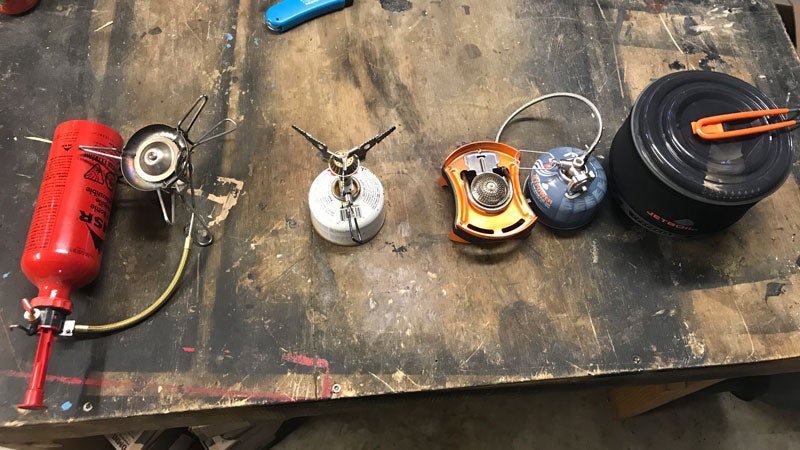
Remote stoves typically refer to canister stoves where the canister attaches to the burner by means of a long hose, as opposed to screwing directly into the canister port. This allows you to invert the canister, dramatically improving efficiency in cold temps. It also brings the stove closer to the ground, generally resulting in improved stability for larger pots. Examples include the Jetboil MilliJoule and GSI Pinnacle 4-Season. Liquid fuel stoves, like the MSR WhisperLite Universal, use a similar setup but burn a variety of fuel sources.
3 Things to Consider Before Buying a Backpacking Stove
No surprise, what you plan to do with your stove will inform what kind of stove to buy. As much as I love my WhisperLite, it’s not my first choice if I’m only going to heat a couple cups of water over the course of a weekend. Conversely, while the GSI Minimalist kit is awesome for quick outings, I wouldn’t take it to Alaska for a few weeks of living on a glacier. Before buying a stove, consider the following three points.
Travel Style:Â If your goal is to hammer out big days, look for simpler, lighter stoves. Canister stoves fit this bill, and the MSR PocketRocket, the Snow Peak LiteMax Titanium, and my choice, the Jetboil MightyMo, are all good options. If you plan on spending a lot of time in camp and want to eat well, consider stoves with a better simmer control and more accessories, such as the Primus Primetech or MSR WindBurner system.
Group Size: A good rule of thumb is .75 liters of pot capacity per person in a cook group. Most pedestal-style stoves aren’t stable enough for more than a 1.5-liter pot—much bigger and you risk losing your meal or burning yourself. If you’re regularly cooking for large groups, remote canister or liquid fuel stoves are lower to the ground and make big pots safer to use.
¶Ů±đ˛őłŮľ±˛Ô˛ąłŮľ±´Ç˛Ô:ĚýIsobutane fuel canisters are increasingly easy to find at outdoor stores worldwide, but they’re not a sure bet, even in smaller American towns without an outdoor store or Walmart. That means stocking up on canisters when traveling off the beaten path or taking a stove such as the WhisperLite Universal that can burn different fuel types. Do not fly to rural Kyrgyzstan and expect to find isobutane canisters.


